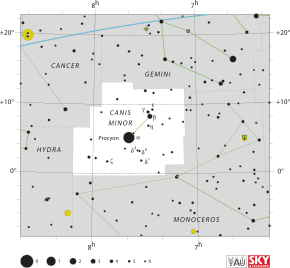
Back Klein Hond (sterrebeeld) Afrikaans الكلب الأصغر (كوكبة) Arabic كانيس مينور ARZ Canis Minor AST Kiçik Köpək (bürc) Azerbaijani Бәләкәй эт (йондоҙлоҡ) Bashkir Малы Пёс (сузор’е) Byelorussian Малы Пёс BE-X-OLD Малко куче Bulgarian ཁྱི་ཕྲུག་སྐར་ཚོམ་ Tibetan
| Constellation | |
 | |
| Abbreviation | CMi |
|---|---|
| Genitive | Canis Minoris |
| Pronunciation | /ˌkeɪnɪs ˈmaɪnər/ KAY-niss MY-nər, genitive /ˌkeɪnɪs mɪˈnɔːrɪs/ KAY-niss min-OR-iss |
| Symbolism | The Lesser Dog |
| Right ascension | 07h 06.4m to 08h 11.4m [1] |
| Declination | 13.22° to −0.36°[1] |
| Area | 183 sq. deg. (71st) |
| Main stars | 2 |
| Bayer/Flamsteed stars | 14 |
| Stars with planets | 1 |
| Stars brighter than 3.00m | 2 |
| Stars within 10.00 pc (32.62 ly) | 4 |
| Brightest star | Procyon (α CMi) (0.34m) |
| Messier objects | 0 |
| Meteor showers | Canis-Minorids |
| Bordering constellations | |
| Visible at latitudes between +90° and −75°. Best visible at 21:00 (9 p.m.) during the month of March. | |
Canis Minor is a small constellation in the northern celestial hemisphere. In the second century, it was included as an asterism, or pattern, of two stars in Ptolemy's 48 constellations, and it is counted among the 88 modern constellations. Its name is Latin for "lesser dog", in contrast to Canis Major, the "greater dog"; both figures are commonly represented as following the constellation of Orion the hunter.
Canis Minor contains only two stars brighter than the fourth magnitude, Procyon (Alpha Canis Minoris), with a magnitude of 0.34, and Gomeisa (Beta Canis Minoris), with a magnitude of 2.9. The constellation's dimmer stars were noted by Johann Bayer, who named eight stars including Alpha and Beta, and John Flamsteed, who numbered fourteen. Procyon is the eighth-brightest star in the night sky, as well as one of the closest. A yellow-white main-sequence star, it has a white dwarf companion. Gomeisa is a blue-white main-sequence star. Luyten's Star is a ninth-magnitude red dwarf and the Solar System's next closest stellar neighbour in the constellation after Procyon. Additionally, Procyon and Luyten's Star are only 1.12 light-years away from each other,[2] and Procyon would be the brightest star in Luyten's Star's sky. The fourth-magnitude HD 66141, which has evolved into an orange giant towards the end of its life cycle, was discovered to have a planet in 2012. There are two faint deep-sky objects within the constellation's borders. The 11 Canis-Minorids are a meteor shower that can be seen in early December.
- ^ a b Cite error: The named reference
boundarywas invoked but never defined (see the help page). - ^ "Annotations on LHS 33 object". SIMBAD. Centre de Données astronomiques de Strasbourg. Retrieved 23 February 2022.